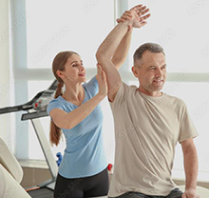Conditions Treated
Pediatric Therapy

Neuro Developmental Therapy
Neuro development therapy works with children and their families with development, learning, behavioural and social/emotional difficultie

Gait training and Balance training
Gait and balance training is physical therapy to improve walking. It may be part of an overall physical therapy program to treat an injury or a physical condition that limits or prohibits the ability to walk or walk correctly.

Autism
Autism also referred to as autism spectrum disorder ̶ constitutes a diverse group of conditions related to development of the brain. About 1 in 100 children has autism. Characteristics may be detected in early childhood, but autism is often not diagnosed until much later

Development delay
When a child's progression through predictable developmental phases slows, stops, or reverses.. Symptoms include slower-than-normal development of motor, cognitive, social, and emotional skills. •Treatment includes occupational therapy, speech therapy and/or physical therapy services.

Attention-deficit/hyperactivity disorder
A chronic condition including attention difficulty, hyperactivity and impulsiveness.
ADHD often begins in childhood and can persist into adulthood. It may contribute to low self-esteem, troubled relationships and difficulty at school or work.

Gross motor development
Gross motor skills are the abilities required to control the muscles of the body for large movements such as crawling, walking, jumping, running, and more. They also include higher-level skills such as climbing, skipping, and throwing and catching a ball.

Sensory integration therapy
which was developed in the 1970s by an OT, A. Jean Ayres, is designed to help children with sensory-processing problems (including possibly those with ASDs) cope with the difficulties they have processing sensory input.

Strengthening and Range of motion
Some authors have proposed that training through a full ROM is necessary to maximize the value of an exercise. Indeed, a majority of research shows that strength adaptations are specific to the joint angle trained; thus, to achieve strength throughout a full ROM, training must involve complete excursion of the joint

Exercise
which was developed in the 1970s by an OT, A. Jean Ayres, is designed to help children with sensory-processing problems (including possibly those with ASDs) cope with the difficulties they have processing sensory input.

Down syndrome
A genetic chromosome 21 disorder causing developmental and intellectual delays.
Down's syndrome is a genetic disorder caused when abnormal cell division results in extra genetic material from chromosome 21 (trisomy 21).

Postural and movement control
Proper postural control is when an individual is able to engage in various static and dynamic activities, such as sitting, standing, kneeling, quadruped, crawling, walking, and running with the ability to contract the appropriate muscles required for a controlled midline posture, as well as the ability to make small .

Cerebral palsy (CP)
CP is a group of disorders that affect a person’s ability to move and maintain balance and posture. CP is the most common motor disability in childhood. Cerebral means having to do with the brain. Palsy means weakness or problems with using the muscles. CP is caused by abnormal brain development or damage to the developing brain that affects a person’s ability to control his or her muscles.

Development skill evaluation
You can use the results of your self-assessment, feedback, and comparison to define your skill improvement goals and plan your action steps. You can also use online tools such as goal-setting apps, learning platforms, or coaching services to track your progress and support your learning